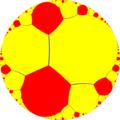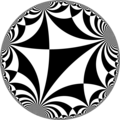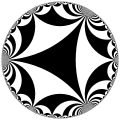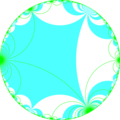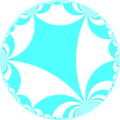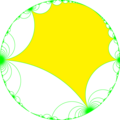Top Qs
Timeline
Chat
Perspective
Order-3 apeirogonal tiling
Periodic tiling of the hyperbolic disk From Wikipedia, the free encyclopedia
Remove ads
In geometry, the order-3 apeirogonal tiling is a regular tiling of the hyperbolic plane. It is represented by the Schläfli symbol {∞,3}, having three regular apeirogons around each vertex. Each apeirogon is inscribed in a horocycle.
| Order-3 apeirogonal tiling | |
|---|---|
 Poincaré disk model of the hyperbolic plane | |
| Type | Hyperbolic regular tiling |
| Vertex configuration | ∞3 |
| Schläfli symbol | {∞,3} t{∞,∞} t(∞,∞,∞) |
| Wythoff symbol | 3 | ∞ 2 2 ∞ | ∞ ∞ ∞ ∞ | |
| Coxeter diagram | |
| Symmetry group | [∞,3], (*∞32) [∞,∞], (*∞∞2) [(∞,∞,∞)], (*∞∞∞) |
| Dual | Infinite-order triangular tiling |
| Properties | Vertex-transitive, edge-transitive, face-transitive |
The order-2 apeirogonal tiling represents an infinite dihedron in the Euclidean plane as {∞,2}.
Remove ads
Images
Each apeirogon face is circumscribed by a horocycle, which looks like a circle in a Poincaré disk model, internally tangent to the projective circle boundary.
The edges of the tiling, shown in blue, form an order-3 Cayley tree.
Uniform colorings
Summarize
Perspective
Like the Euclidean hexagonal tiling, there are 3 uniform colorings of the order-3 apeirogonal tiling, each from different reflective triangle group domains:
Symmetry
The dual to this tiling represents the fundamental domains of [(∞,∞,∞)] (*∞∞∞) symmetry. There are 15 small index subgroups (7 unique) constructed from [(∞,∞,∞)] by mirror removal and alternation. Mirrors can be removed if its branch orders are all even, and cuts neighboring branch orders in half. Removing two mirrors leaves a half-order gyration point where the removed mirrors met. In these images fundamental domains are alternately colored black and white, and mirrors exist on the boundaries between colors. The symmetry can be doubled as ∞∞2 symmetry by adding a mirror bisecting the fundamental domain. Dividing a fundamental domain by 3 mirrors creates a ∞32 symmetry.
A larger subgroup is constructed [(∞,∞,∞*)], index 8, as (∞*∞∞) with gyration points removed, becomes (*∞∞).
Remove ads
Related polyhedra and tilings
Summarize
Perspective
This tiling is topologically related as a part of sequence of regular polyhedra with Schläfli symbol {n,3}.
Functions on tilings
Functions on this tiling that have symmetry properties tied to it are called modular functions; the modular forms are a special case. This is visually evident in the visualizations of Klein's j-invariant on the Poincaré disk, as well as the Eisenstein series.
See also
Wikimedia Commons has media related to Order-3 apeirogonal tiling.
- Tilings of regular polygons
- List of uniform planar tilings
- List of regular polytopes
- Hexagonal tiling honeycomb, similar {6,3,3} honeycomb in H3.
References
Wikiwand - on
Seamless Wikipedia browsing. On steroids.
Remove ads




